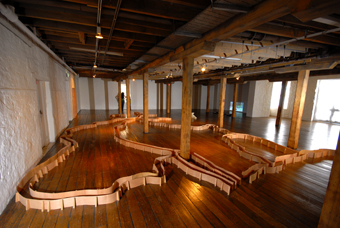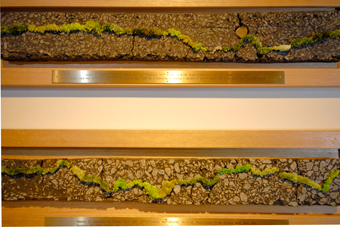 |
Lucy Bleach, Circumnarrative photo Craig Opie |
The wooden structure is probably the most puzzling of the three works. Two parallel lines of 10cm high plywood curve around the timber floor forming the likeness of a walled road or some other passageway. It dodges the gallery pillars in a way that a plant would, the organic nature of its movement suggesting that nature may have been an inspiration. Yet it still looks very much built, with its exposed supports and its likeness is to roads which track a journey through what appears to me to be the gradually evolving shape of Tasmania. I strain to remember the locations of the roads I have travelled in my own short time in the state: Eaglehawk Neck, Burnie, Launceston.
 |
Lucy Bleach, Circumnarrative photo Craig Opie |
The third work, the lightbox mounted outside on a neighbouring wall depicts a landscape view with a freestanding gate, through which can be seen the edge of the land over the ocean. Even without the gate, the typically bleak Tasmanian landscape would seem hostile; but the gate adds an extra physical barrier to the land. It is also cleverly placed out of reach in the space between the buildings—an island of colour and light against the sandstone wall.
Circumnavigate is an initially incohesive work, but on closer reflection, the three parts share an underlying theme. I perceive an outsider’s view of Tasmania. As with many small communities, Tasmania has a cliquey nature that many newcomers to state find initially alienating and hostile. Perhaps, coming from Sydney, Bleach has experienced this ‘outsider’ phenomenon. The wooden structure may suggest the roads of Tasmania, but also a sense of exclusion: these ‘roads’ are created out of relatively tall barriers, preventing not only entrance but also escape. The wall plaques share with us intimate comments, but are presented in a strangely objective manner, suggesting the view of another kind of ‘outsider.’
Circumnavigate is beautifully mysterious: the structure which evolves as you walk around it and consider the shape of the whole and the journey within; the intriguing plaques with the fleeting stories of ordinary Hobart workers and the overlooked remnants of their efforts made permanent; and the landscape, sectioned off twice in a bid to keep out the stranger. It takes time to enter Lucy Bleach’s work, however the reward is coming to a unique understanding of Tasmanian as ‘an other place’.
Lucy Bleach, Circumnarrative (2007), An Other Place, curator Sean Kelly; Long Gallery, Salamanca Arts Centre, Ten Days on the Island, March 23-April 1
Lucy Hawthorne is a Hobart based writer with a background in visual arts (sculpture, drawing, sound and installation art), music and dog obsession. She is a postgraduate studying art and design theory at the Tasmanian School of Art.
© Lucy Hawthorne; for permission to reproduce apply to [email protected]








 back
back